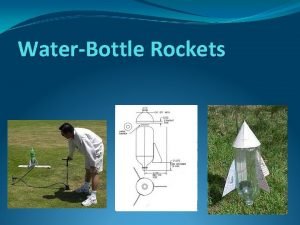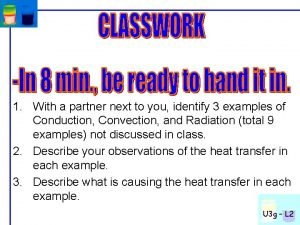An Introduction to Water Rockets Water Rockets What















































- Slides: 47

An Introduction to Water Rockets

Water Rockets (What I Have Learned so Far) by Bill Kuhl http: //www. scienceguy. org The idea to try water rockets came to me after helping with a parks and recreation summer camp that was entitled, "Model Airplanes and Rockets". For at least one summer there were no rockets but we built kites instead of rockets, and of course there was little wind. I had built solid fuel rockets as a kid but I knew that would be rather expensive for a large group, so I thought the water rocket idea would be cheap once I purchased a launcher. Some people build their own launchers, but I purchased the better launcher from Pitsco.

At first, I just built rockets that had no recovery system at all, this makes things simple if the rocket survives the crash.

Kids really enjoy launching the water rockets.

Successful parachute deployment, not easy without a system to push nose off.

Next few pictures are from a parks and recreation group, they built the rockets mainly from construction paper which does not hold up to a high-speed launch, but the kids sure had fun!

Blast Off!!!

Rocket came apart on high-speed launch.


The Launch

The launch of a water rocket is really fun to watch, within the first few feet all the water has been emptied from the bottle and the rocket can be going over 100 m. p. h. ! Safe practices are a must.


For water rockets you need a good quality pump, the pump on the left was a cheap one and did not hold up. The pump on the right has gauge which is necessary.

In this picture you can see the jaws clamping around the bottle.

Some method for carrying and pouring water is needed at the launch site.

Parachute recovery is really cool, but it is difficult to get reliable deployment every time, I tried a few methods with varying success.



Below is what happens when the parachute does not deploy. Sometimes you can fix the rocket but sometimes it is best to try a new rocket and another approach.



What are the problems and how can I fix it, that is what I thought about all the time. In the picture above the fin material was not stiff enough for the size of the rocket and was fluttering in flight. Altitude is greatly reduced when that happens.

Another problem I had was with the parachute lines twisting, using a fishing swivel helped this greatly.

Fishing swivel helped with the twisted lines.

I tried many materials for the rocket fins; foam, cardboard from a milk carton, and plastic from cottage cheese lids. The material needs to be rigid enough and waterproof.

Fins cut from the lids of cottage cheese containers.

Fins cut from foam.

I also experimented with an Anti. Gravity. Research rocket which uses A small hole in the nozzle which results in a slower launch.

A view from below.

Small hole changes the characteristics of the thrust, slower launch.

The yellow tube is inserted into small hole in the cap. Automatically releases rocket when you stop pumping.

Anti. Gravity. Research rocket ready for launch, expensive launcher is not needed.

Foam nose bumper fastened with rubber bands.

Fins are held on with rubber bands, white tube is a launch guide.

The next few pictures are of a Pitsco Saber rocket I built from a kit. An air chamber that was held squeezed down by vacuum and released slowly when the flap on the rocket came off was used for parachute deployment. This worked well for several launches and then it failed for two launches. It was a simple method for parachute deployment if only it was always reliable.

I taped the bottle when painting to create a water level indicator.

Depressing the air chamber.

The air flap hold vacuum in air chamber, flap rips off at launch, releasing the vacuum which pushes the nose off.

Nose pushed off.

First rocket I built with a timer system. Spring mechanism pulls a pin which releases a spring that pushes nose off. It is fun to engineer new solutions and to refine the solutions.

Timer is in the bottom-right, servo arm is attached to the knob on timer, string attached to servo arm pulls out the pin.

When pin is pulled out, a compressed spring pushes hinge up and the rod that pushes the nose off.

Long rod pushes the nose off, I will refine this in future versions.

Braided wire holds the timer until rocket launches which pulls the wire out releasing the timer.

Parachute deployed successfully!!

Touchdown!

Be sure to watch my video, An Introduction to Water Rockets I on You. Tube. Contact me by email at scienceguy 33@gmail. com Bill Kuhl
 Water and water and water water
Water and water and water water Waterbottle rockets
Waterbottle rockets Newton's third law
Newton's third law Equation for aerodynamic drag
Equation for aerodynamic drag Nick rebecca
Nick rebecca What are newtons 3 laws
What are newtons 3 laws Johnny rockets fresno
Johnny rockets fresno Vasimr engine
Vasimr engine Tree rockets
Tree rockets Model rockets
Model rockets Types of roots in maths
Types of roots in maths Science revision quiz
Science revision quiz Roaring rockets powerpoint
Roaring rockets powerpoint Brief history of rockets
Brief history of rockets Body paragraph
Body paragraph Water purification conclusion
Water purification conclusion Water pollution objectives
Water pollution objectives Introduction of water pollution
Introduction of water pollution Introduction of water pollution
Introduction of water pollution Save water introduction
Save water introduction Water pollution introduction
Water pollution introduction School water audit
School water audit Rumus fwa
Rumus fwa How can we reuse water for class 3
How can we reuse water for class 3 Alberto rode 5/8 of the water rides at a water park
Alberto rode 5/8 of the water rides at a water park A paved blacktop parking lot was built
A paved blacktop parking lot was built Water heat exchanger
Water heat exchanger Fresh water meets salt water
Fresh water meets salt water Warm water rises in a lake. cold water descends.
Warm water rises in a lake. cold water descends. Water water everywhere project
Water water everywhere project Important water resources
Important water resources Unit 11 water water everywhere
Unit 11 water water everywhere Conclusion of learning without burden
Conclusion of learning without burden What is yacc
What is yacc Example of speech essay conclusion
Example of speech essay conclusion Essay introduction examples
Essay introduction examples Abstract vs introduction
Abstract vs introduction How long is an introduction
How long is an introduction Introduction in email
Introduction in email What is a bridge in an introduction paragraph
What is a bridge in an introduction paragraph Introduction answer the question
Introduction answer the question Informative essay introduction
Informative essay introduction Editorial writing examples
Editorial writing examples Advantages and disadvantages writing
Advantages and disadvantages writing Introduction on research proposal
Introduction on research proposal Diary writing
Diary writing Meg character traits
Meg character traits Jane schaffer introduction paragraph example
Jane schaffer introduction paragraph example





































































